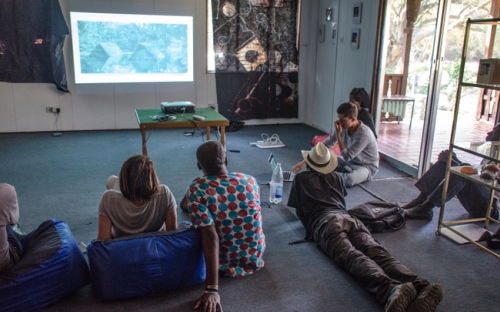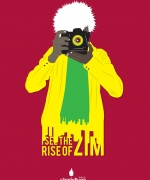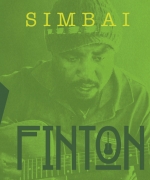Surinamese artist Xavier Robles de Medina in Zimbabwe
Xavier Robles de Medina is a Surinamese artist working in painting and sculpture. His sensibilities are deeply rooted in an observational drawing practice as well as an objective dissection of the painting as a three-dimensional object. He questions social and artistic categorizations, in search for a truth regarding his identity as it relates to the painting tradition. His distinctions during his BFA include First Place for Black and White Drawing, as well as the Canson Award at the 2010 Foundations Honours Show. His work has been published on the cover of Strathmore canvas pads, the cover of the Savannah College of Art and Design graduate catalog, and reviewed in both Sranan Art Xposed vol. 5 and the Savannah Morning News. In 2012 Robles de Medina graduated from the Savannah College of Art and Design, in the USA, with BFA’s in Painting and Animation. In 2014, Robles de Medina was a guest speaker at the Academie voor Hoger Kunst – en Cultuuronderwijs, in Paramaribo, Suriname. Robles de Medina has exhibited internationally and is represented by Catinca Tabacaru Gallery in NY. He is currently an artist in residence at WOW, Amsterdam, where he lives and works.
How you did you get to go to Dzimbanhete and the artist residency
Catinca had been hinting at doing a residency in Zimbabwe for some time. When plans started to solidify with Dzimbanhete Arts Interactions I got even more excited that we were going to be hosted by one of the pillars of the Zimbabwe art community. For me it made a lot of sense because of my history and culture as a Surinamese person, and dealing with certain issues of politics and identity in my work. And coming from a culture that is strongly influenced and connected to the African continent, I just knew it was going to be hugely inspiring.
What were your expectations of Zimbabwe and first impressions on arriving in Zimbabwe
I tried not to develop any expectations, regardless of what I had heard and read beforehand. When I arrived in Harare I was supposed to be picked up, but I think there was some confusion regarding my arrival time and because it was the middle of the night the airport was empty except for some taxi’s and one guy working at an airport shop, and even though I must have seemed completely weird and foreign to him he lent me his personal cell phone without hesitation. So I really felt a strong friendliness and hospitality from the moment I landed, and that is my prime impression of the people I met; a boundless empathy for others, even for complete strangers.
Are there any similarities between Zimbabwe and Suriname?
There are so many similarities that I noticed both in the bigger picture and in how people seem to treat each other on a personal level. Zimbabwe is a much larger country, and the population is ethnically less diverse so I wasn’t expecting the similarities to be as pervasive. But both exist in a post-colonial climate and achieved independence around the same time; after independence both faced huge challenges and went through periods of extreme economic hardship accompanied by hyperinflation and corruption, and I believe these factors determined many of the social and cultural similarities.
I noticed there is a sincerity, warmth, and approachability that is also very reminiscent of Suriname. There are so many similarities in micro details in cuisine, music, aesthetics, spirituality - too many to name, which is probably very directly resulted from the African diaspora, and cultural exchanges between Africa and the Caribbean.
Your work is a mixture of painting, sculpture, graphite pencil any preference medium, what determines the medium you use?
Sometimes I’ll think that the material I use is just practical, and that what makes the work is actually a particular way I transform the material. But then, I’ll try to paint with acrylic, or watercolour and realize that I really just don’t like using it, or somehow it doesn’t compliment my hand as well so it certainly isn’t arbitrary. Most of the time, I’ll have an idea for a subject and concept and immediately envision it in a particular material. In general I have a strong tendency to engage in a hyper-refining and super-smoothing; I think about surface a lot and achieving a luscious and rich texture to carry the form and subject to the degree where emotional and conceptual meaning is completely intertwined with the way I use the materials. Even when there is a subject and discernible form, I believe the work lives in this abstract realm where the material is just as much subject as the literal depiction.
What inspired the body of sculptures that include “A Freeze is Coming’?
When I lived in Bed-Stuy, a very Caribbean neighbourhood in Brooklyn, I noticed these advertisements for hair products everywhere. On a personal level this reminded me a lot of Surinamese contemporary culture; at the same time it also made me think of Abstract Expressionist painters, and then strangely also of Renaissance or Baroque painting, because of the dynamism. All of these allusions strongly encouraged me to explore these images further, so I started to dissect them by cutting them into grids and rearranging them to be completely abstract fields of organic form. The form in the collages read so strongly to me, that I knew the works needed to be translated into sculptures or friezes. The materials I used for those works are also largely from similarities I drew between elements in Pop culture and painting history. “A Freeze is Coming” is made from a naturally black urethane, the actual same material used for Batman merchandise objects, like the Bat mobile toy, an object that is synonymous to painting in that it is in a chronic state of transformation.
“Counter” looks like Samora Machel former Mozambican president and Cecil John Rhodes, British imperialist, an unlikely team. Can you tell us more about the two men in that painting and what inspired it?
The men who inspired “Counter” are Wilfred Hawker and Surendre Rambocus, who attempted a counter-coup against the military regime in Suriname in 1981. Both men were executed, and the history of this event, the injustice, the trauma lingers and remains unresolved. The source image I used for the painting was already so symbolic of the way these events have been remembered or more so forgotten, that translating it through paint in a particular hazy manner becomes an homage to these men, but also to an archetype, a history many countries with a dictatorship or communist past share.
What is your understanding of contemporary art?
I feel very fortunate that I have been able to study painting in the United States, where the professors and education I enjoyed were excellent. It also gave me a strong understanding of one of the most important foundations of the contemporary art world: art education at university level. In New York City I was able to work for several art manufacturing companies and learned about that side of the contemporary art world, the importance of paying attention to detail, the culture of outsourcing and superstar artists and mega galleries. Furthermore, I was able to form a partnership with Catinca Tabacaru Gallery, which has taught me a lot about the contemporary art world in relation to what I do and who I am. I feel grateful to know the contemporary art world in Suriname, and now in Zimbabwe as well, where art is not really commoditised or even valued to the degree it is in wealthier countries; only the absolute most extreme art die-hards stick around and in many ways that makes it interesting. I think my understanding of the contemporary art world mainly lives as a culmination of all these experiences and insights.
Do you have work that you say “This is mine” Not for sale, not even for exhibition?
I don’t at all. I spend so much time with the work, conceptualizing, creating, and refining, that by the time the work is finished and hanging on the wall I feel it’s very much over. Not dead, but to me I’m done with it, and I’m probably more interested in the next work/idea. Right now sales make me very happy, to know that someone likes it enough to spend money on it and hang it in their house. I think that’s the best part of being young and relatively unknown: whenever I sell work I feel confident it’s coming from a very real emotional need to live with the work, right now I want to just revel in that and offer up everything I do.
What did you take away from your interactions at Dzimbanhete?
Just the memory of all the amazing people I was able to hang out with for a month, the conversations, the moments when everything clicked and we felt so strongly connected, as well as the moments of tension and friction where we had to talk things out and work through issues. Also I feel I got to know Catinca, Raphael, Justin, and Rachel, a lot better in certain scenarios we wouldn’t have shared anywhere else, and living with them for a month really strengthened our friendship.
One particular aspect I’ve been thinking about a lot is the music culture. Certain people I met at Dzimbanhete would spend the whole day with music, playing the mbira, walking around with it, and I want to adopt that attitude in my own practice more. This complete effortless sense, that it’s not second nature, but first nature, and casual.
What are your thoughts on the art scene in Zimbabwe from what you were exposed to? Any advice to the artists you worked with?
The Zimbabwe art scene is really very strong, like I said before, I believe it’s a small group of highly committed artists and art supporters. I wish I could have spent more time in some of the artist’s personal studios; I should really be asking artists like Admire Kamudzengerere, Misheck Masamvu, and Chiko Chazunguza for advice! But the advice I would give students and younger artists is to study these amazing individuals who are fully committed to culture, community, and making work.
What else did you get up to while in Zimbabwe?
We went to Mbare and experienced Harare city life quite a bit. We also did some touristy things like Great Zimbabwe, and Snake World. We were very lucky that most of the galleries in Harare were having openings and events during the time we were there, so outside of the residency and the artists we met through that, I feel we were privileged in gaining an understanding of how things operate in the city and in galleries there.
You represented your country at tennis, Why did you not pursue a career in tennis?
I’m too short.
You have done short stories are you still writing?
During my stay in Zimbabwe I did come up with a plot about a foreigner who travels to an exotic land and gets attacked by baboons while meditating in the forest, though this idea requires quite a bit of refining. I think my short stories and writing are an extension of my greater passion for metaphor, composition, and human narrative. In a sense my drawings and paintings are also like poems or short stories. There is a relationship to language in everything I do thus writing is never completely divorced from my process.





